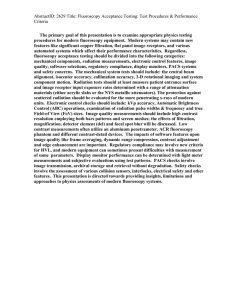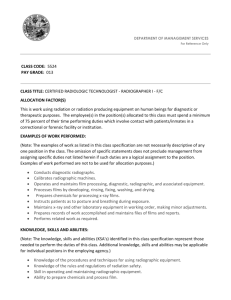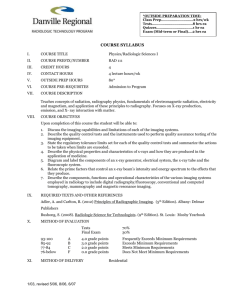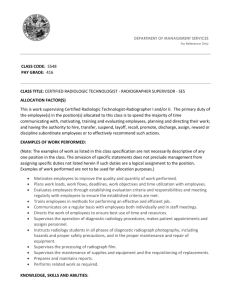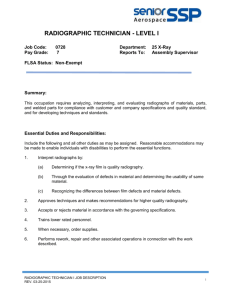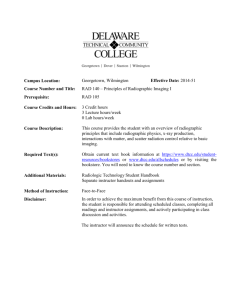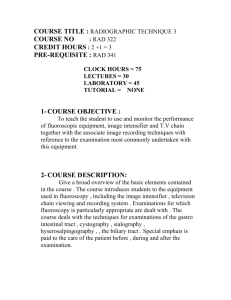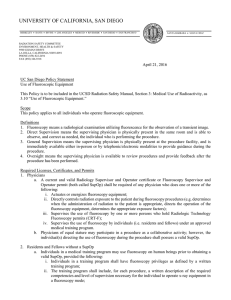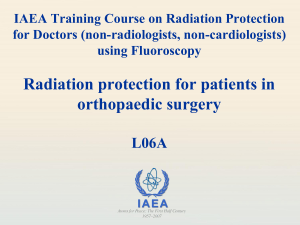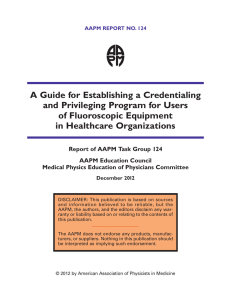ARTICLE 2 - El Camino College
advertisement
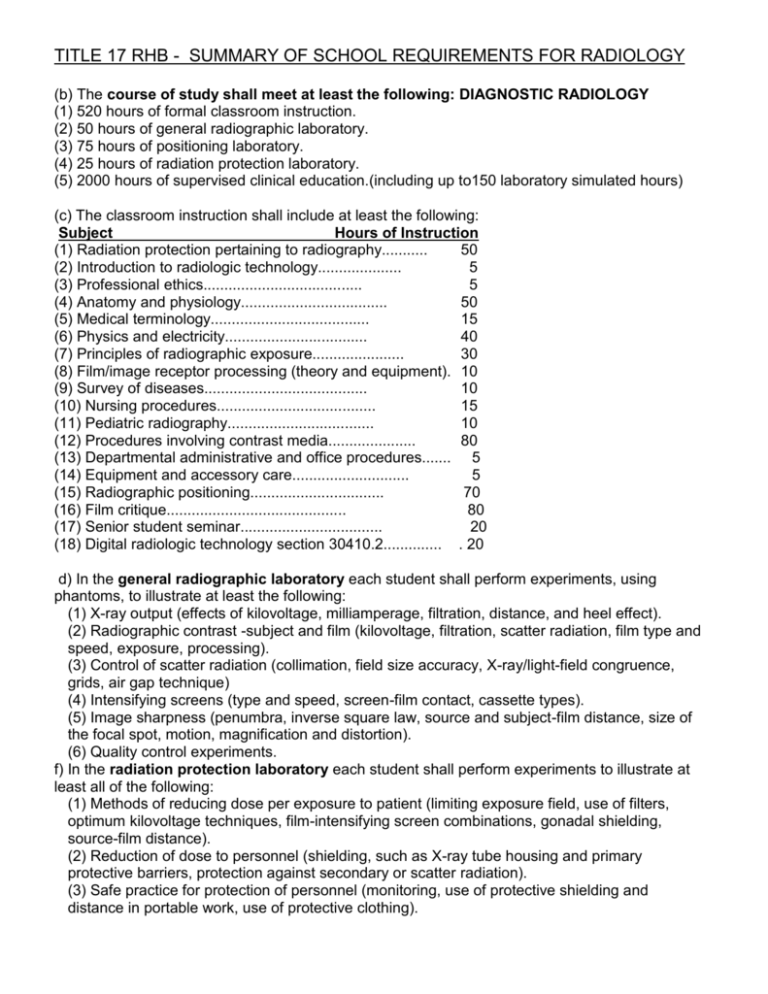
TITLE 17 RHB - SUMMARY OF SCHOOL REQUIREMENTS FOR RADIOLOGY (b) The course of study shall meet at least the following: DIAGNOSTIC RADIOLOGY (1) 520 hours of formal classroom instruction. (2) 50 hours of general radiographic laboratory. (3) 75 hours of positioning laboratory. (4) 25 hours of radiation protection laboratory. (5) 2000 hours of supervised clinical education.(including up to150 laboratory simulated hours) (c) The classroom instruction shall include at least the following: Subject Hours of Instruction (1) Radiation protection pertaining to radiography........... 50 (2) Introduction to radiologic technology.................... 5 (3) Professional ethics...................................... 5 (4) Anatomy and physiology................................... 50 (5) Medical terminology...................................... 15 (6) Physics and electricity.................................. 40 (7) Principles of radiographic exposure...................... 30 (8) Film/image receptor processing (theory and equipment). 10 (9) Survey of diseases....................................... 10 (10) Nursing procedures...................................... 15 (11) Pediatric radiography................................... 10 (12) Procedures involving contrast media..................... 80 (13) Departmental administrative and office procedures....... 5 (14) Equipment and accessory care............................ 5 (15) Radiographic positioning................................ 70 (16) Film critique........................................... 80 (17) Senior student seminar.................................. 20 (18) Digital radiologic technology section 30410.2.............. . 20 d) In the general radiographic laboratory each student shall perform experiments, using phantoms, to illustrate at least the following: (1) X-ray output (effects of kilovoltage, milliamperage, filtration, distance, and heel effect). (2) Radiographic contrast -subject and film (kilovoltage, filtration, scatter radiation, film type and speed, exposure, processing). (3) Control of scatter radiation (collimation, field size accuracy, X-ray/light-field congruence, grids, air gap technique) (4) Intensifying screens (type and speed, screen-film contact, cassette types). (5) Image sharpness (penumbra, inverse square law, source and subject-film distance, size of the focal spot, motion, magnification and distortion). (6) Quality control experiments. f) In the radiation protection laboratory each student shall perform experiments to illustrate at least all of the following: (1) Methods of reducing dose per exposure to patient (limiting exposure field, use of filters, optimum kilovoltage techniques, film-intensifying screen combinations, gonadal shielding, source-film distance). (2) Reduction of dose to personnel (shielding, such as X-ray tube housing and primary protective barriers, protection against secondary or scatter radiation). (3) Safe practice for protection of personnel (monitoring, use of protective shielding and distance in portable work, use of protective clothing). § 30410.2. Instruction in Digital Radiologic Technology. (a) Instruction in digital radiologic technology shall be no less than 20 hours in length and shall include all of the following: (1) Basic principles of digital radiography addressing digital image characteristics, types of digital receptors in cassette-less systems and cassette-based systems, comparison of detector properties and evaluative criteria, and dynamic range versus latitude; (2) Image acquisition addressing raw data acquisition, and image extraction and exposure indicators in cassette-less and cassette-based systems; (3) Image acquisition errors addressing exposure field recognition, histogram analysis error, low intensity radiation response, scatter control such as coning and use of optimal exposures, and grid use including Moire effect; (4) Software (default) image processing addressing automatic rescaling, final image processing, effects of excessive processing, and recognition of image processing errors that affect image clarity; (5) Fundamental principles of exposure addressing optimal receptor exposure, receptor response and detective quantum efficiency, selection of exposure factors, exposure myths associated with digital imaging systems, controlling patient exposure, monitoring patient exposure; (6) Image evaluation addressing evidence of appropriate exposure level and exposure recognition failure or histogram analysis error, contrast, recorded detail, and artifacts; (7) Quality assurance and maintenance issues addressing initial acceptance testing, cassettebased system reader preventive maintenance, plate maintenance, uniformity of default processing codes, and reject analysis; and (8) Image display issues to include types of viewing monitors as compared to film/screen, picture archiving and communication systems, teleradiology, and operator responsibilities such as image annotation and manipulation, and patient confidentiality. § 30423. Radiologic Technologist Fluoroscopy Permit Schools. (a) In order to be approved by the Department as a radiologic technologist fluoroscopy permit school, a school shall offer a course of study that includes in its curriculum all requirements of subsections (b) and (c) of this section. (b) The classroom instruction shall include at least the following: Subject Hours of Instruction (1) Fluoroscopy regulations and radiation safety...... 10 (2) Fluoroscopy equipment............................. 5 (3) X-ray image intensifiers.......................... 4 (4) Television, including closed circuit equipment.... 4 (5) Image recording and image recording equipment..... 6 (6) Special fluoroscopy equipment..................... 5 (7) Mobile image intensified units.................... 2 (8) Anatomy and physiology of the eye................. 2 (9) Three-dimensional and radiological anatomy........ 2 (c) At least 15 hours of laboratory in which each student shall conduct experiments on phantoms to illustrate at least the following: (1) Methods of reducing dose to patients during fluoroscopy procedures. (2) Methods of reducing exposure to self and personnel. (3) Image recording during the exposure of phantom. (4) Quality control of fluoroscopy equipment. e) In the positioning laboratory each student shall: (1) Position simulated patients for routine X-ray procedures to illustrate different patient care situations. (2) Perform on phantoms X-ray procedures to illustrate the selection of exposure factors, proper positioning, film and other image receptor processing/developing techniques. (g) In the supervised clinical education each student shall perform or assist in the performance of not less than the following number of radiographic procedures: Procedures Number (1) Chest........................................... 200 (2) Bony skeleton...................................400 (3) Gastrointestinal and genitourinary....200 (4) Vascular and contrast studies..............50 (5) Special studies and X-ray imaging modalities.... 50 (6) Bedside and surgical...........................50
